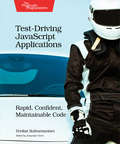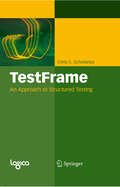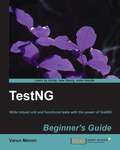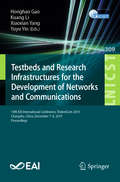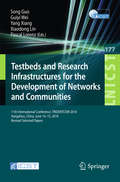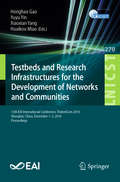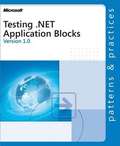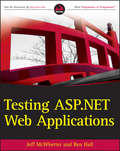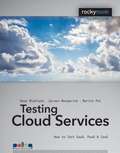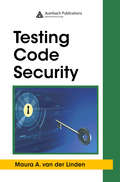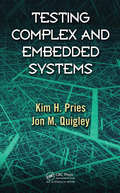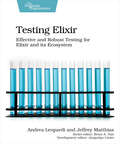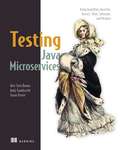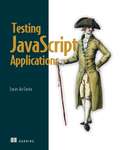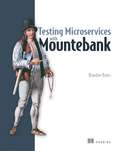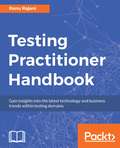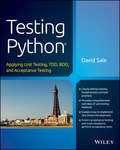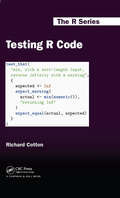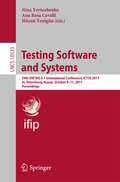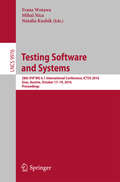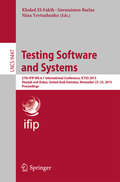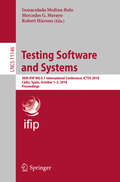- Table View
- List View
Test-Driving JavaScript Applications: Rapid, Confident, Maintainable Code
by Venkat SubramaniamDebunk the myth that JavaScript is not easily testable. Whether you use Node.js, Express, MongoDB, jQuery, AngularJS, or directly manipulate the DOM, you can test-drive JavaScript. Learn the craft of writing meaningful, deterministic automated tests with Karma, Mocha, and Chai. Test asynchronous JavaScript, decouple and properly mock out dependencies, measure code coverage, and create lightweight modular designs of both server-side and client-side code. Your investment in writing tests will pay high dividends as you create code that's predictable and cost-effective to change.Design and code JavaScript applications with automated tests. Writing meaningful tests is a skill that takes learning, some unlearning, and a lot of practice, and with this book, you'll hone that skill. Fire up the editor and get hands-on through practical exercises for effective automated testing and designing maintainable, modular code.Start by learning when and why to do manual testing vs. automated verification. Focus tests on the important things, like the pre-conditions, the invariants, complex logic, and gnarly edge cases. Then begin to design asynchronous functions using automated tests. Carefully decouple and mock out intricate dependencies such as the DOM, geolocation API, file and database access, and Ajax calls to remote servers.Step by step, test code that uses Node.js, Express, MongoDB, jQuery, and AngularJS. Know when and how to use tools such as Chai, Istanbul, Karma, Mocha, Protractor, and Sinon. Create tests with minimum effort and run them fast without having to spin up web servers or manually edit HTML pages to run in browsers. Then explore end-to-end testing to ensure all parts are wired and working well together.Don't just imagine creating testable code, write it.What You Need:A computer with a text editor and your favorite browser. The book provides instructions to install the necessary automated testing-related tools.
TestComplete Cookbook
by Gennadiy AlpaevIf you are a software tester or a programmer who is involved with testing automation using TestComplete, this book is ideal for you! You will be introduced to the very basics of using the tool, as well as polish any previously gained knowledge in using the tool. If you are already aware of programming basics, but are new to TestComplete, you will also be able to quickly learn the concepts through selected examples that are easily scalable for your specific needs.
TestFrame: An Approach to Structured Testing
by Chris C. SchotanusOver 12 years ago Logica started the development of TestFrame®, a test method which enables organizations to develop and execute their tests in a structured way. Since then many new techniques have been developed, such as, most recently, "Service Oriented Architectures (SOAs)" or "Software as a Service (SaaS)" , requiring updates to test procedures and processes that seemed well-established. These trends have prompted Logica to update and renew the TestFrame® method. Chris Schotanus’ new book takes into account the recent developments and his presentation is focused on supporting daily test practice. Every step within this structured test method is dealt with exhaustively, providing the reader with the necessary details for successful software testing. Yet his book will not only help test personnel to improve effectivity, it will also serve as a way to improve efficiency through its strong focus on reuse. This makes TestFrame the practical guide to testing information systems for everyone involved in software testing – test developers, test managers, and staff charged with quality assurance.
TestNG Beginner's Guide
by Varun MenonThis book is written in a friendly, beginner's guide style with plenty of step-by-step instructions with appropriate examples.This book is great for developers and testers who are new to TestNg and want to learn how to use TestNG for writing their application as well as functional tests. This book assumes that you have experience in Java and OOPs concepts and have worked with certain IDE.
Testable JavaScript: Ensuring Reliable Code
by Mark Ethan TrostlerOne skill that’s essential for any professional JavaScript developer is the ability to write testable code. This book shows you what writing and maintaining testable JavaScript for the client- or server-side actually entails, whether you’re creating a new application or rewriting legacy code.From methods to reduce code complexity to unit testing, code coverage, debugging, and automation, you’ll learn a holistic approach for writing JavaScript code that you and your colleagues can easily fix and maintain going forward. Testing JavaScript code is complicated. This book helps experienced JavaScript developers simply the process considerably.Get an overview of Agile, test-driven development, and behavior-driven developmentUse patterns from static languages and standards-based JavaScript to reduce code complexityLearn the advantages of event-based architectures, including modularity, loose coupling, and reusabilityExplore tools for writing and running unit tests at the functional and application levelGenerate code coverage to measure the scope and effectiveness of your testsConduct integration, performance, and load testing, using Selenium or CasperJSUse tools for in-browser, Node.js, mobile, and production debuggingUnderstand what, when, and how to automate your development processes
Testbeds and Research Infrastructures for the Development of Networks and Communications: 14th EAI International Conference, TridentCom 2019, Changsha, China, December 7-8, 2019, Proceedings (Lecture Notes of the Institute for Computer Sciences, Social Informatics and Telecommunications Engineering #309)
by Honghao Gao Yuyu Yin Xiaoxian Yang Kuang LiThis book constitutes the refereed post-conference proceedings of the 14th EAI International Conference on Testbeds and Research Infrastructures for the Development of Networks and Communications, TridentCom 2019, held in December 2019 in Changsha, China. The 10 full papers were selected from 62 submissions and are grouped into three sessions: AI and Internet Computing; QoS, Reliability, Modeling and Testing; and Wireless, Networking and Multimedia Application.
Testbeds and Research Infrastructures for the Development of Networks and Communities
by Yang Xiang Xiaodong Lin Song Guo Pascal Lorenz Guiyi WeiThis book constitutes the refereed proceedings of the 11th International Conference on Testbeds and Research Infrastructures for the Development of Networks and Communities, TridentCom 2016, held in Hangzhou, China, in June 2016. The 16 papers were carefully selected from 25 submissions and provide a forum about technologies of big data, cyber physical systems and computer communications. The papers consist of 4 sessions covering future Internet and software defined network, network testbed design and implementation, testbed for network applications, and QoS/QoE on networks.
Testbeds and Research Infrastructures for the Development of Networks and Communities: 13th EAI International Conference, TridentCom 2018, Shanghai, China, December 1-3, 2018, Proceedings (Lecture Notes of the Institute for Computer Sciences, Social Informatics and Telecommunications Engineering #270)
by Honghao Gao Yuyu Yin Xiaoxian Yang Huaikou MiaoThis book constitutes the refereed post-conference proceedings of the 13th EAI International Conference on Testbeds and Research Infrastructures for the Development of Networks and Communications, TridentCom 2018, held in November 2018 in Shanghai, China. The 10 full papers were selected from 29 submissions and are grouped into three sessions: wireless and testbed application; uncertainty analytics and formal verification; knowledge graph.
Testing .NET Application Blocks
by Microsoft CorporationComplex software environments require more in-depth testing. This book delivers the detailed guidance you need to plan and execute testing for the solutions you develop with Microsoft PATTERNS & PRACTICES application blocks. Whether you're customizing the application blocks or integrating them into existing applications, you'll understand the key considerations for verifying that your code meets its requirements for performance, availability, scalability, compatibility, globalization, and security features. You'll find code examples, sample test cases, and checklists that demonstrate how to plan and implement each type of test; the guide also recommends tools to use to run the tests. While this book was designed specifically for use in testing Microsoft PATTERNS & PRACTICES application blocks, it also provides an excellent resource for testing other .NET code. All PATTERNS & PRACTICES guides are reviewed and approved by Microsoft engineering teams, consultants, partners, and customers--delivering accurate, real-world information that's been technically validated and tested.
Testing ASP.NET Web Applications
by Jeff Mcwherter Ben HallA unique resource that combines all aspects of Web testing and makes it completely specific to ASP. NET As Microsoft's key Web technology for creating dynamic, data-driven Web sites and Web applications, ASP. NET is incredibly popular. This is the first book to combine several testing topics and make them specific to ASP. NET. The author duo of Microsoft MVPs covers both the test-driven development approach and the specifics of automated user interface testing; performance, load, and stress testing; accessibility testing; and security testing. This definitive guide walks you through the many testing pitfalls you might experience when developing ASP. NET applications. The authors explain the fundamental concepts of testing and demystify all the correct actions you need to consider and the tools that are available so that you may successfully text your application. Author duo of Microsoft MVPs offer a unique resource: a combination of several testing topics and making them specific to ASP. NET, Microsoft's key Web technology for creating dynamic, data-driven Web sites and applications Guides you through the many testing pitfalls you may experience when developing ASP. NET applications Reviews the fundamental concepts of testing and walks you through the various tools and techniques available and for successfully testing an application Discusses several different types of testing: acceptance, stress, accessibility, and security Examines various testing tools, such as nUnit, VS test suite, WCAT, Selenium, Fiddler, Firebug, and more This one-of-a-kind resource will help you become proficient in successfull application testing.
Testing Angular Applications
by Corinna Cohn Michael Giambalvo Jesse Palmer Craig NishinaSummaryTesting Angular Applications is an example-rich, hands-on guide that gives you the real-world techniques you need to thoroughly test all parts of your Angular applications. By the end of this book, you'll be able to confidently write unit and end-to-end tests for Angular applications in TypeScript.Foreword by Brad Green, Google.Purchase of the print book includes a free eBook in PDF, Kindle, and ePub formats from Manning Publications.About the TechnologyDon't leave the success of your mission-critical Angular apps to chance. Proper testing improves code quality, reduces maintenance costs, and rewards you with happy users. New tools and best practices can streamline and automate all aspects of testing web apps, both in development and in production. This book gets you started.About the BookTesting Angular Applications teaches you how to make testing an essential part of your development and production processes. You'll start by setting up a simple unit testing system as you learn the fundamental practices. Then, you'll fine-tune it as you discover the best tests for Angular components, directives, pipes, services, and routing. Finally, you'll explore end-to-end testing, mastering the Protractor framework, and inserting Angular apps into your continuous integration pipeline.What's insideGetting to know TypeScriptWriting and debugging unit testsWriting and debugging end-to-end tests with ProtractorBuilding continuous integration for your entire test suiteAbout the ReaderThis book is for readers with intermediate JavaScript skills.About the AuthorJesse Palmer is a senior engineering manager at Handshake. Corinna Cohn is a single-page web application specialist. Mike Giambalvo and Craig Nishina are engineers at Google.Table of ContentsIntroduction to testing Angular applicationsPART 1 - Unit testingCreating your first testsTesting componentsTesting directivesTesting pipesTesting servicesTesting the routerPART 2 - End-to-end testingGetting started with ProtractorUnderstanding timeoutsAdvanced Protractor topicsPART 3 - Continuous integrationContinuous integrationAppendix A - Setting up the sample projectAppendix B - Additional resources
Testing Cloud Services
by Jeroen Mengerink Martin Pol Kees BloklandEverybody is confronted with cloud computing. Whether you are a user, designer, programmer, project manager, or tester, sooner or later the cloud affects your work. If you are involved in selecting or implementing services from the cloud, or in keeping them up and running, this book will prove to be an invaluable resource. Testing Cloud Services covers an extensive list of risks that arise when implementing cloud computing, including some traditional risks and some completely new ones, and provides strategies for avoiding these risks and solving problems. Every risk is connected to existing, updated, and new test measures. It is necessary to start testing during the selection of cloud services, and continue end-to-end testing even after going live, as continuity risks arise all the time. With this book in hand, you will save a lot of time and discover an effective approach to testing that can be applied in practice immediately!
Testing Code Security
by Maura A. van der LindenThe huge proliferation of security vulnerability exploits, worms, and viruses place an incredible drain on both cost and confidence for manufacturers and consumers. The release of trustworthy code requires a specific set of skills and techniques, but this information is often dispersed and decentralized, encrypted in its own jargon and terminology,
Testing Complex and Embedded Systems
by Jon M. Quigley Kim H. PriesMany enterprises regard system-level testing as the final piece of the development effort, rather than as a tool that should be integrated throughout the development process. As a consequence, test teams often execute critical test plans just before product launch, resulting in much of the corrective work being performed in a rush and at the last minute. Presenting combinatorial approaches for improving test coverage, Testing Complex and Embedded Systems details techniques to help you streamline testing and identify problems before they occur—including turbocharged testing using Six Sigma and exploratory testing methods. Rather than present the continuum of testing for particular products or design attributes, the text focuses on boundary conditions. Examining systems and software testing, it explains how to use simulation and emulation to complement testing. Details how to manage multiple test hardware and software deliveries Examines the contradictory perspectives of testing—including ordered/ random, structured /unstructured, bench/field, and repeatable/non repeatable Covers essential planning activities prior to testing, how to scope the work, and how to reach a successful conclusion Explains how to determine when testing is complete Where you find organizations that are successful at product development, you are likely to find groups that practice disciplined, strategic, and thorough testing. Tapping into the authors’ decades of experience managing test groups in the automotive industry, this book provides the understanding to help ensure your organization joins the likes of these groups.
Testing Elixir: Effective And Robust Testing For Elixir And Its Ecosystem
by Andrea Leopardi Jeffrey MatthiasElixir offers new paradigms, and challenges you to test in unconventional ways. Start with ExUnit: almost everything you need to write tests covering all levels of detail, from unit to integration, but only if you know how to use it to the fullest - we'll show you how. Explore testing Elixir-specific challenges such as OTP-based modules, asynchronous code, Ecto-based applications, and Phoenix applications. Explore new tools like Mox for mocks and StreamData for property-based testing. Armed with this knowledge, you can create test suites that add value to your production cycle and guard you from regressions. Write Elixir tests that you can be proud of. Dive into Elixir's test philosophy and gain mastery over the terminology and concepts that underlie good tests. Create and structure a comprehensive ExUnit test suite, starting from the basics, and build comprehensive test coverage that will provide safety for refactoring and confidence that your code performs as designed. Use tests to make your software more reliable and fault tolerant. Explore the basic tool set provided by ExUnit and Mix to write and organize your test suite. Test code built around different OTP functionality. Isolate your code through dependency injection and by using Mox. Write comprehensive tests for Ecto projects, covering Ecto as a database tool as well as a standalone data validation tool. Test Phoenix channels from end to end, including authentication and joining topics. Write Phoenix controller tests and understand the concepts of integration testing in Elixir. Learn property-based testing with StreamData from the author who wrote the library. Code with high confidence that you are getting the most out of your test suite, with the right tools that make testing your code a pleasure and a valuable part of your development cycle. What You Need: To get the most out of this book, you will need to have installed Elixir 1.8 or later and Erlang/OTP 21 or later. In order to complete the relevant chapters, you will also need Ecto 3.1 or later, EctoSQL 3.1 or later and Phoenix 1.3 or later.
Testing Java Microservices: Using Arquillian, Hoverfly, AssertJ, JUnit, Selenium, and Mockito
by Jason Porter Alex Soto Andrew GumbrechtSummaryTesting Java Microservices teaches you to implement unit and integration tests for microservice systems running on the JVM. You'll work with a microservice environment built using Java EE, WildFly Swarm, and Docker. You'll learn how to increase your test coverage and productivity, and gain confidence that your system will work as you expect.Purchase of the print book includes a free eBook in PDF, Kindle, and ePub formats from Manning Publications.About the TechnologyMicroservice applications present special testing challenges. Even simple services need to handle unpredictable loads, and distributed message-based designs pose unique security and performance concerns. These challenges increase when you throw in asynchronous communication and containers.About the BookTesting Java Microservices teaches you to implement unit and integration tests for microservice systems running on the JVM. You'll work with a microservice environment built using Java EE, WildFly Swarm, and Docker. You'll advance from writing simple unit tests for individual services to more-advanced practices like chaos or integration tests. As you move towards a continuous-delivery pipeline, you'll also master live system testing using technologies like the Arquillian, Wiremock, and Mockito frameworks, along with techniques like contract testing and over-the-wire service virtualization. Master these microservice-specific practices and tools and you'll greatly increase your test coverage and productivity, and gain confidence that your system will work as you expect.What's InsideTest automationIntegration testing microservice systemsTesting container-centric systemsService virtualizationAbout the ReaderWritten for Java developers familiar with Java EE, EE4J, Spring, or Spring Boot.About the AuthorsAlex Soto Bueno and Jason Porter are Arquillian team members. Andy Gumbrecht is an Apache TomEE developer and PMC. They all have extensive enterprise-testing experience.Table of ContentsAn introduction to microservicesApplication under testUnit-testing microservicesComponent-testing microservicesIntegration-testing microservicesContract testsEnd-to-end testingDocker and testingService virtualizationContinuous delivery in microservices
Testing JavaScript Applications
by Lucas Fernandes da CostaTesting JavaScript Applications teaches you how to implement an automated testing plan for JavaScript-based web applications.Summary Automated testing will help you write high-quality software in less time, with more confidence, fewer bugs, and without constant manual oversight. Testing JavaScript Applications is a guide to building a comprehensive and reliable JS application testing suite, covering both how to write tests and how JS testing tools work under the hood. You&’ll learn from Lucas de Costa, a core contributor to popular JS testing libraries, as he shares a quality mindset for making testing decisions that deliver a real contribution to your business. You&’ll benefit from informative explanations and diagrams, easily-transferable code samples, and useful tips on using the latest and most consolidated libraries and frameworks of the JavaScript ecosystem. Purchase of the print book includes a free eBook in PDF, Kindle, and ePub formats from Manning Publications. About the technology Automated testing is essential to delivering good JavaScript applications every time. A complete testing strategy needs to cover functions in isolation, integration between different parts of your code, and correctness from the end user&’s perspective. This book will teach you how to deliver reliable software quickly and confidently. About the book Testing JavaScript Applications teaches you how to implement an automated testing plan for JavaScript-based web applications. It describes practical testing strategies, covers useful tools and libraries, and explains how to foster a culture of quality. In this clearly-written, example-rich book, you&’ll explore approaches for both backend and frontend applications and learn how to validate your software much more quickly and reliably. What's inside Unit, end-to-end, and integration testing Managing test cost and complexity Practicing test-driven development Dealing with external dependencies Tools like like Jest and Cypress About the reader For junior JavaScript developers. About the author Lucas da Costa is a core maintainer of Chai and Sinon.JS, two of the most popular testing tools in the JavaScript ecosystem, and contributed to numerous other open-source projects, including Jest. Table of Contents PART 1 - TESTING JAVASCRIPT APPLICATIONS 1 An introduction to automated testing 2 What to test and when? Part 2 - WRITING TESTS 3 Testing techniques 4 Testing backend applications 5 Advanced backend testing techniques 6 Testing frontend applications 7 The React testing ecosystem 8 Testing React applications 9 Test-driven development 10 UI-based end-to-end testing 11 Writing UI-based end-to-end tests PART 3 - BUSINESS IMPACT 12 Continuous integration and continuous delivery 13 A culture of quality
Testing Microservices with Mountebank
by Brandon ByarsSummaryTesting Microservices with Mountebank is your guide to the ins and outs of testing microservices with service virtualization. The book offers unique insights into microservices application design and state-of-the-art testing practices that will deepen your microservices skills and improve your applications.Purchase of the print book includes a free eBook in PDF, Kindle, and ePub formats from Manning Publications.About the TechnologyEven if you lab test each service in isolation, it's challenging—and potentially dangerous—to test a live microservices system that's changing and growing. Fortunately, you can use Mountebank to "imitate" the components of a distributed microservices application to give you a good approximation of the runtime conditions as you test individual services.About the BookTesting Microservices with Mountebank introduces the powerful practice of service virtualization. In it, author Brandon Byars, Mountebank's creator, offers unique insights into microservices application design and state-of-the-art testing practices. You'll expand your understanding of microservices as you work with Mountebank's imposters, responses, behaviors, and programmability. By mastering the powerful testing techniques in this unique book, your microservices skills will deepen and your applications will improve. For real.What's insideThe core concepts of service virtualizationTesting using canned responsesProgramming MountebankPerformance testingAbout the ReaderWritten for developers familiar with SOA or microservices systems.About the AuthorBrandon Byars is the author and chief maintainer of Mountebank and a principal consultant at ThoughtWorks.Table of ContentsPART 1 - FIRST STEPSTesting microservicesTaking mountebank for a test drivePART 2 - USING MOUNTEBANKTesting using canned responsesUsing predicates to send different responsesAdding record/replay behaviorProgramming mountebankAdding behaviorsProtocolsPART 3 - CLOSING THE LOOPMountebank and continuous deliveryPerformance testing with mountebank
Testing Practitioner Handbook
by Renu RajaniGain insights into the latest technology and business trends within testing domains About This Book • This book covers the latest trends that every Testing and QA professional should keep up-to-date with given the advancements in digital technologies. • Master cutting-edge testing techniques for emerging areas such as IOT, Machine Learning, Cognitive. • Best practices for Testing and Quality Assurance within several industry domains. Who This Book Is For This book is targeted at those working in the QA and Testing areas. The book does not cover testing basics, which QA professional are already familiar with—for example, writing a test plan or test case, and so on. What You Will Learn • Understand the TCOE model, managed services, the structure of testing in Agile/DevOps engagements, factory models, and crowdsourcing • Implement testing processes, practices, and automation tools in the Agile/DevOps life cycle • Adapt to current technologies in social media, mobile, analytics and the Cloud • Leverage cognitive intelligence/machine-learning, robotics, and the Internet of Things in testing • How key industries/domains (consumer products and retail, energy and utilities, healthcare, telecom, and automotive) adapt to digital transformation • Future directions for the QA industry, consulting careers, testing profession, and professionals In Detail The book is based on the author`s experience in leading and transforming large test engagements and architecting solutions for customer testing requirements/bids/problem areas. It targets the testing practitioner population and provides them with a single go-to place to find perspectives, practices, trends, tools, and solutions to test applications as they face the evolving digital world. This book is divided into five parts where each part explores different aspects of testing in the real world. The first module explains the various testing engagement models. You will then learn how to efficiently test code in different life cycles. The book discusses the different aspects of Quality Analysis consideration while testing social media, mobile, analytics, and the Cloud. In the last module, you will learn about futuristic technologies to test software. By the end of the book, you will understand the latest business and IT trends in digital transformation and learn the best practices to adopt for business assurance. Style and approach This book is a compilation of the latest business and IT trends in digital transformation & Tools and Best Practices that QA professionals need to adopt for business assurance.
Testing Python
by David SaleFundamental testing methodologies applied to the popular Pythonlanguage Testing Python; Applying Unit Testing, TDD, BDD andAcceptance Testing is the most comprehensive book available ontesting for one of the top software programming languages in theworld. Python is a natural choice for new and experienceddevelopers, and this hands-on resource is a much needed guide toenterprise-level testing development methodologies. The book willshow you why Unit Testing and TDD can lead to cleaner, moreflexible programs.Unit Testing and Test-Driven Development (TDD) are increasinglymust-have skills for software developers, no matter what languagethey work in. In enterprise settings, it's critical for developersto ensure they always have working code, and that's what makestesting methodologies so attractive. This book will teach you themost widely used testing strategies and will introduce to you tostill others, covering performance testing, continuous testing, andmore.Learn Unit Testing and TDD--important developmentmethodologies that lie at the heart of Agile developmentEnhance your ability to work with Python to develop powerful,flexible applications with clean codeDraw on the expertise of author David Sale, a leading UKdeveloper and tech commentatorGet ahead of the crowd by mastering the underappreciated worldof Python testingKnowledge of software testing in Python could set you apart fromPython developers using outmoded methodologies. Python is a naturalfit for TDD and Testing Python is a must-read text foranyone who wants to develop expertise in Python programming.
Testing R Code (Chapman & Hall/CRC The R Series)
by Richard CottonLearn how to write R code with fewer bugs. The problem with programming is that you are always one typo away from writing something silly. Likewise with data analysis, a small mistake in your model can lead to a big mistake in your results. Combining the two disciplines means that it is all too easy for a missed minus sign to generate a false prediction that you don’t spot until it’s too late. Testing is the only way to be sure that your code, and your results, are correct. Testing R Code teaches you how to perform development-time testing using the testthat package, allowing you to ensure that your code works as intended. The book also teaches run-time testing using the assertive package; enabling your users to correctly run your code. After beginning with an introduction to testing in R, the book explores more advanced cases such as integrating tests into R packages; testing code that accesses databases; testing C++ code with Rcpp; and testing graphics. Each topic is explained with real-world examples, and has accompanying exercises for readers to practise their skills — only a small amount of experience with R is needed to get started!
Testing Software and Systems
by Nina Yevtushenko Ana Rosa Cavalli Hüsnü YenigünThis book constitutes the refereed proceedings of the 29th IFIP WG 6. 1 International Conference on Testing Software and Systems ICTSS 2017, held in St. Petersburg, Russia, in October 2017. The 18 full papers and 4 short papers presented were carefully reviewed and selected from 41 submissions. The topics of the volume cover model based testing; test derivation and monitoring; fault localization and system testing including real time systems.
Testing Software and Systems
by Franz Wotawa Mihai Nica Natalia KushikThis book constitutes the refereed proceedings of the 278th IFIP WG 6. 1 International Conference on Testing Software and Systems, ICTSS 2016, held in Graz, Austria, in October 2016. The 12 revised full papers and 6 short papers presented were carefully reviewed and selected from 41 submissions. The papers are organized in topical sections on testing methodologies, heuristics and non-determinism in testing, practical applications, and short contributions.
Testing Software and Systems
by Nina Yevtushenko Khaled El-Fakih Gerassimos BarlasThis book constitutes the refereed proceedings of the 27th IFIP WG 6. 1 International Conference on Testing Software and Systems, ICTSS 2015, held in Sharjah and Dubai, United Arab Emirates, in November 2015. The 14 revised full papers and 4 short papers presented were carefully reviewed and selected from 42 submissions. The papers are organized in topical sections on model based testing, test derivation methods, monitoring and fault localization, model and system testing, and real-time systems.
Testing Software and Systems: 30th IFIP WG 6.1 International Conference, ICTSS 2018, Cádiz, Spain, October 1-3, 2018, Proceedings (Lecture Notes in Computer Science #11146)
by Inmaculada Medina-Bulo Mercedes G. Merayo Robert HieronsThis book constitutes the refereed proceedings of the 30th IFIP WG 6.1 International Conference on Testing Software and Systems, ICTSS 2018, held in Cádiz, Spain, in October 2018. The 8 regular and 6 short papers presented were carefully reviewed and selected from 29 submissions. ICTSS is a series of international conferences addressing the conceptual, theoretic, and practical problems of testing software systems, including communication protocols, services, distributed platforms, middleware, embedded- and cyber-physical-systems, and security infrastructures.
